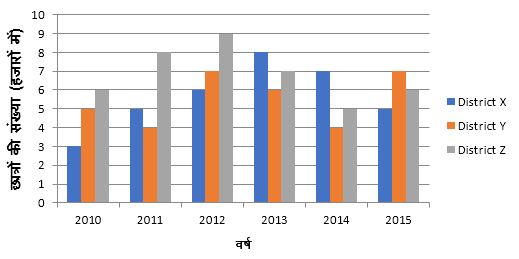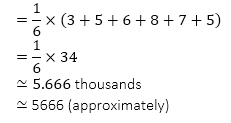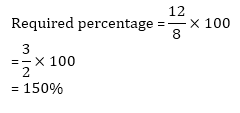Q1. विश्व स्वास्थ्य संगठन और सहयोगी विश्व प्रत्येक वर्ष तंबाकू रहित दिवस (WNTD) किस दिन मानते हैं?
Q2. भारत और यूके के बीच तीसरा गृह मामले वार्ता हाल ही में ______________ में आयोजित किया गया.
Q3. भारत सहित 26 देशों ने, जून 2018 में दुनिया के सबसे बड़े अंतरराष्ट्रीय समुद्री द्विवार्षिक अभ्यास में भाग लिया है, जिसका नाम ___________ है.
Q4. उत्तराखंड में पिथौरागढ़ में भारत और नेपाल के बीच संयुक्त सैन्य अभ्यास सूर्या किरण शुरू हो गया है. यह इस अभ्यास का __________ संस्करण है.
Q5. NIBM बैंकिंग और वित्त में अनुसंधान, प्रशिक्षण और परामर्श का एक भारतीय संस्थान है. NIBM में "B" का क्या अर्थ है?
Directions (6-10): नीचे दी गई संख्याओं के समूह का अध्ययन कीजिए और निम्नलिखित प्रश्नों के उत्तर दीजिये:
427 581 839 275 589
Q6. यदि सबसे बड़ी संख्या का दूसरा अंक निम्नतम संख्या के दूसरा अंक से घटाया जाता है तो निम्न में से कौन सी संख्या प्राप्त होगी?
Q7. यदि प्रत्येक संख्या में, पहले और अंतिम अंक आपस में बदल दिए जाते हैं, तो निम्न में से कौन सी सबसे बड़ी संख्या होगी?
724 185 938 572 985
Q8. यदि प्रत्येक संख्या में दूसरे और तीसरे अंक आपस में बदल दिए जाते हैं, तो दूसरी सबसे छोटी संख्या कौन सी होगी?
472 518 893 257 598
Q9. यदि प्रत्येक संख्या के अंतिम अंक से एक घटाया जाता है और फिर पहले और तीसरे अंक को आपस में बदल दिया जाता है, तो निम्न में से कौन सा निम्नतम होगा?
426 580 838 274 588
624 085 838 472 885
Q10. यदि प्रत्येक संख्या में, सभी तीन अंकों को आरोही क्रम में व्यवस्थित किया जाता है, तो निम्न में से कौन सी सबसे बड़ी संख्या होगी?
247 158 389 257 589
Directions (11-15): In the passage given below there are blanks which are to be filled with the options given below. Find out the appropriate word in each case which can most suitably complete the sentence without altering the meaning of the statement.
Q11. Inequality occurs in many (11) ……………………., only some of which are economic. And when we speak of economic inequality, again the reference is to a very large canvas, which must be (12) ……………………. very severely in the interests of tractability. Accordingly, by “economic inequality”, we shall mainly mean interpersonal inequality in the distribution of incomes. This is as good a place as any to observe that the enterprise of measurement—including that of socio-economic (13) …………………. such as poverty and inequality—has tended to trigger two types of reaction among practitioners. On the one hand, we have the “measurement fetishists”—those who seldom see poverty or inequality as felt, experienced, human conditions beyond the boundaries of equations and formulas. At the other extreme, we have the “measurement nihilists”—those who regard measurement as a cold, calculating, soulless exercise (14) ………………….. by “experts” who trade in (15) ……………………. symbols and unreliable data to construct misleading pictures of reality.
Q12. Inequality occurs in many (11) ……………………., only some of which are economic. And when we speak of economic inequality, again the reference is to a very large canvas, which must be (12) ……………………. very severely in the interests of tractability. Accordingly, by “economic inequality”, we shall mainly mean interpersonal inequality in the distribution of incomes. This is as good a place as any to observe that the enterprise of measurement—including that of socio-economic (13) …………………. such as poverty and inequality—has tended to trigger two types of reaction among practitioners. On the one hand, we have the “measurement fetishists”—those who seldom see poverty or inequality as felt, experienced, human conditions beyond the boundaries of equations and formulas. At the other extreme, we have the “measurement nihilists”—those who regard measurement as a cold, calculating, soulless exercise (14) ………………….. by “experts” who trade in (15) ……………………. symbols and unreliable data to construct misleading pictures of reality.
Q13. Inequality occurs in many (11) ……………………., only some of which are economic. And when we speak of economic inequality, again the reference is to a very large canvas, which must be (12) ……………………. very severely in the interests of tractability. Accordingly, by “economic inequality”, we shall mainly mean interpersonal inequality in the distribution of incomes. This is as good a place as any to observe that the enterprise of measurement—including that of socio-economic (13) …………………. such as poverty and inequality—has tended to trigger two types of reaction among practitioners. On the one hand, we have the “measurement fetishists”—those who seldom see poverty or inequality as felt, experienced, human conditions beyond the boundaries of equations and formulas. At the other extreme, we have the “measurement nihilists”—those who regard measurement as a cold, calculating, soulless exercise (14) ………………….. by “experts” who trade in (15) ……………………. symbols and unreliable data to construct misleading pictures of reality.
Q14. Inequality occurs in many (11) ……………………., only some of which are economic. And when we speak of economic inequality, again the reference is to a very large canvas, which must be (12) ……………………. very severely in the interests of tractability. Accordingly, by “economic inequality”, we shall mainly mean interpersonal inequality in the distribution of incomes. This is as good a place as any to observe that the enterprise of measurement—including that of socio-economic (13) …………………. such as poverty and inequality—has tended to trigger two types of reaction among practitioners. On the one hand, we have the “measurement fetishists”—those who seldom see poverty or inequality as felt, experienced, human conditions beyond the boundaries of equations and formulas. At the other extreme, we have the “measurement nihilists”—those who regard measurement as a cold, calculating, soulless exercise (14) ………………….. by “experts” who trade in (15) ……………………. symbols and unreliable data to construct misleading pictures of reality.
Q15. Inequality occurs in many (11) ……………………., only some of which are economic. And when we speak of economic inequality, again the reference is to a very large canvas, which must be (12) ……………………. very severely in the interests of tractability. Accordingly, by “economic inequality”, we shall mainly mean interpersonal inequality in the distribution of incomes. This is as good a place as any to observe that the enterprise of measurement—including that of socio-economic (13) …………………. such as poverty and inequality—has tended to trigger two types of reaction among practitioners. On the one hand, we have the “measurement fetishists”—those who seldom see poverty or inequality as felt, experienced, human conditions beyond the boundaries of equations and formulas. At the other extreme, we have the “measurement nihilists”—those who regard measurement as a cold, calculating, soulless exercise (14) ………………….. by “experts” who trade in (15) ……………………. symbols and unreliable data to construct misleading pictures of reality.
छह अलग-अलग वर्षों में तीन अलग-अलग जिलों में दाखिला लेने वाले छात्रों की संख्या (हजारों में)
Q16. पिछले वर्ष की तुलना में वर्ष 2012 में जिला-Z में छात्रों की संख्या के नामांकन में प्रतिशत वृद्धि कितनी थी?
Q17. वर्ष 2013 में सभी तीन जिलों में नामांकित छात्रों की संख्या और सभी वर्षों में जिला-Y में नामांकित छात्रों की संख्या के मध्य कितना अंतर था?
= 12,000
Q18. सभी वर्षों में जिला-X में नामांकित छात्रों की अनुमानित औसत संख्या कितनी थी?
Q19. सभी तीन जिलों में नामांकित छात्रों की संख्या दूसरी सबसे अधिक किस वर्ष थी?
∴ Students enrolled in 2012
= (6 + 7 + 9) = 22 thousand and students enrolled in 2013
= (8 + 6 + 7) = 21 thousand
∴ second highest enrolled students are in 2013
Q20. वर्ष 2015 में जिला-X और जिला-Y में नामांकित छात्रों की कुल संख्या वर्ष 2013 में जिला-X में नामांकित छात्रों की कुल संख्या की कितने प्रतिशत थी?

















